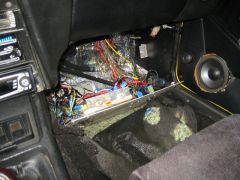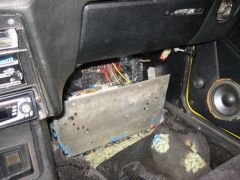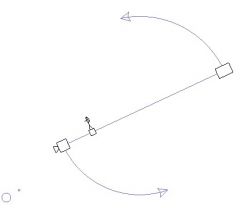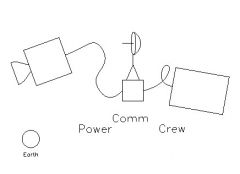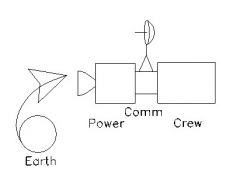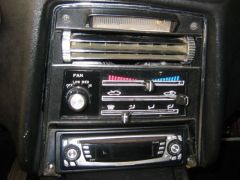-
Posts
497 -
Joined
-
Last visited
-
Days Won
2
Content Type
Profiles
Forums
Blogs
Events
Gallery
Downloads
Store
Everything posted by strotter
-
Mike, I was going to say you're being too cynical, but on further reflection (as I am wont to do before posting), some dark part of me is afraid you're probably right. However, I'd restate your sentiment; Americans will indeed look up into the night sky and marvel, folks from some other countries will look through their helmets and do the same. Other countries are just now moving into space, decades behind us, true, but they're doing it for entirely different reasons than us - they don't think of it as a race against some enemy, they think of it as a race against a competitor. Such a sentiment is the kind of thing that can be kept up for generations. It's a long-term investment to them, basically economic ass-covering. And of course, somebody will eventually figure out how to make a whole bunch of money, and then it'll be well and truly on.
-

JCI T56 trans mount issue?
strotter replied to auxilary's topic in Gen III & IV Chevy V8Z Tech Board
Yeah, my '72 required some fairly significant coercion. Use something to distribute the force of the blows, it'll be virtually invisible both inside the cockpit and under the car. -

Cash 4 Clunkers List - Some Amazing Cars Destroyed!
strotter replied to slownrusty's topic in Non Tech Board
OK, this sounded like it might have a teeny political spin to it, so I checked the cars.gov site. There's a "Report" section, where a variety of different data is available, including a list of all cars taken for trade-in. The list is up-to-date at Friday, October 16, 2009 at 3:00PM EDT. Note that the list is a .zip'd .xls file. A quick perusal disclosed there are 677081 cars listed, of 8102 "types" (make/model). Turns out the story has been "massaged" a bit... There is a DB7 (it's a '97) There is a Typhoon (6) Porsche 928 including (2) S4 >>> 11 Porsches, including 5 928's, 2 S4's , but all 928's are crap <<< (4) Gen. IV Supras >>> 18 "Celica Supra", 300 Supra's, w/ 4 listed as "Category 1 Truck" (?) <<< (5,000+) Mercedes-Benz including (142) SL, (3) S600, a 1994 E500 (crying), a 1992 500E (more crying), 1995 C36 and 1999 C43 >>> Didn't check, unimpressed with MB's <<< (3,500+) BMWs including an M3, M5, Z3, 850i and (3) 740il >>> CORRECT, but 2 740il's <<< GMC Typhoon >>> 1 <<< Buick Grand National >>> NONE <<< Aston Martin DB7 >>> NONE <<< Bentley Continental R >>> NONE <<< If you download the file, be sure to resort the sheet, as it's initially sorted by "Trade_in_Vehicle_Category", such as "Light Pickup", "Passenger Car", and the vehicles are often not in the correct category (seems for instance to be a lot of BMW pickups I didn't know about). Looking through the list, seems like it's mostly clunkers. Huh. Interesting thing about the program, the dealers had the option of buying the cars outright. Why would a dealer pass up a DB7? Doesn't seem to make sense. I'll check into that more... -

Where are people mounting ECUs in S30s (not 280Zs)
strotter replied to z-ya's topic in S30 Series - 240z, 260z, 280z
Here's a pic of the aluminum plate partially swung open. And here's one of it open about as far as it will go Advantages: 1) it's easy to get to, 2) it's easy to see and access the components, 3) it's easy to get to all the wiring feeding the components, 4) it's fairly invisible when closed up and covered with the carpet. Disadvantages: 1) there's a huge wire tangle, (which is going to happen whenever you put all the electronics in one place), 2) it jams on the door sill as it swings open (which is more about my design than the geometry of the car), 3) it steals a few inches of legroom (which is really the big one for me; it's OK with da ladeez (mine is 5' 6"), but a normal-sized guy is a bit jammed), 4) I had to adjust the carpet aft about 3". If I were doing it again, and I probably will, I'd make a "sub-glovebox" hinged at the firewall just below the big wiring opening, but closing against the bottom of the dash. It would swing downward for access. That way, passengers can stretch their legs out, but it maintains the easy access of this arrangement. -
Derek, I'm looking at the condition of the plastic on the main part of the center panel. The finish is beautiful. Is that the original, or have you redone it somehow? Mine looks like it's been through a grinder....
-

Where are people mounting ECUs in S30s (not 280Zs)
strotter replied to z-ya's topic in S30 Series - 240z, 260z, 280z
I did something like this, but I created a false floor, standing about 3" off the original bulkhead. Made it out of .15 aluminum sheet, which I wired as a ground plane, and then used as a mount for the computer, wideband box, relays, wire routing etc. It tilts out for access on a pair of hinges mounted on the floor, locks in place with a pair of butterfly nuts on the kick panel and tunnel. -
I have a Gen1 v8, and run a T56 and enjoy it greatly. It's tough and bulletproof. I'd like to chime in though and point out that a v8 Z doesn't need a manual to provide startling performance, especially around town - flat torque curves are considered "good" for a reason. Most of the time I shift 1-3-5, and maybe 6 if I'm going over 60 for any distance. Modern automatics are reliable, available, and easy to deal with. Most any ratios are just fine with a light car, locking tc's provide excellent cruising efficiency, and an aggressive shift kit can grab a gear faster than a clutch any day. Finally, I can tell you without reservation that rowing a 6-speed is great, but gets old real quick on a Thursday afternoon in August in stop-and-go traffic. Once you put a v8 in a Z car, you are not going to have a boring ride, no matter your choice.
-
I know this is a bit late for you, but for everyone else: Radio Shack has little LED's in a threaded housing, in red, blue, green, and yellow. 12v, about 3/16" diameter, about 1" deep, with a nut to mount them. Fairly bright when lit. BTW, a good place to mount little teeny LED's is on the steering shaft housing cover, below the key. It's easily visible when driving, easy to get to, and does not disrupt the "original" lines too much. I've got my high-beam indicator, as well as 2 others as telltales for my cooling fans.
-
Car thieves will often burn a car to get rid of fingerprints. Back in the day, my old Monte Carlo was burned that way, all they took was the battery.
-
I don't mean just at transition points in the flow, I mean dimpling the entire length of the pipe. Think about it: exhaust flow is high velocity, turbulent, and in constant (pulsing) stir. Boundary friction effects are bound to be high. Our Z's (or any lowered vehicle) are clearance-challenged, so a smaller-diameter yet low back-pressure exhaust system might be welcome. Might not be hard to test...
-
You know, we built one of these, right? We aren't going to use it, but we built it....
-
Google "solar sail" in quotes, you'll get a lot of hits - and there are plenty of pictures in Google Images. If you think that's cool technology, there are some things people are working on right now that qualify as outrageously cool, and doable with current techology - imagine a relatively small sail (say 1000 feet square, a million square feet), small enough to be held together with some structure. You loft and deploy it in a fairly high orbit ('cause you don't want atmospheric problems, which happen even in low orbit). Now imagine you've built a couple of great big continuous lasers on the ground, something in the gigawatt range, ideally in the mountains of Antarctica and up in northern Canada or Russia. You aim your lasers at the spacecraft and pull the trigger, blammo you're pushing the payload with a whole lot more thrust than you'd get from just the sun. The reason you build it near the poles is that you want to be able to hit it 24/7 for months or years at a time. Note that the vehicle is on its own for deceleration at the target, but you've saved a *bunch* of fuel, and at the Jovians you can always use aerobraking maneuvers to slow down. On the way back, the vessel is again on its' own for the initial impulse, but once it gets back near Earth it deploys the sail again, the lasers come back online, now they can decelerate the whole thing, again saving fuel. How about this one: there are literally millions of asteroids in our solar system, with all kinds of ridiculous orbits. You find a medium-sized one (say something a few hundred feet in diameter, made up of nickel/iron and other scruff) that orbits between the asteroid belt and crosses Earth. Such an orbit would take five or six years to complete. You send a series of robots there, to modify the orbit as necessary and to make it a habitable base. Building materials (nickel and iron) are already present by the ton, all the robots have to do is drill holes in it to make airtight chambers, or heat it up and melt it into the shapes you want. You send a series of small payloads up there, possibly over a period of several orbits, each time making the base more and more habitable. Eventually you end up with a fully-stocked habitat on which you can ride in comfort to any part of the inner system. This way, you don't have to loft the materials from Earth, and you don't need as many launches to get the "heavy" stuff where you need it. How about this one: you send a robot to the asteroid belt (between Mars and Jupiter), find a small asteroid (a hundred million tons or so, made of nickel and iron, good stuff and nearly pure) and attach a solar sail. If you have ground lasers per the system mentioned above, all the better, but you don't have to have them. You give it a gentle push in such a way as to slow it down a bit. Its' orbit having been modified, it starts to fall to the inner system. As it gets close to Earth, you send another robot, this time carrying thrusters of some kind so as to fine-tune its' trajectory. You aim it at Antarctica, boom, great light show and you've got a hundred million tons of really valuable, almost pure ore sitting on the ice at the cost of a couple of robots. You think space exploration can't pay for itself? There's all kinds of kewl ideas out there.
-
This setup really doesn't really involve the expansion tank at all; you can keep it or lose it at your pleasure.
-
Your boys are in my territory now (ex aerospace engineer), so I'm gonna have to school ya. 1. You don't need multi-generational spacecraft to get to anyplace inside the solar system, all you need is really really patient astronauts. You can get to Mars in 6-9 months using current heavy-lift boosters and low-impulse chemical motors. Make the injection motors nuclear (SNAP, Nerva class fission, nothing fancy 60's tech) and you'd cut that in half. Saturn would take about twice that (depending on course & fuel requirements). Times get larger with large payloads. 2. Artificial gravity is probably not necessary to Mars, but would be for any of the Jovians. It's not hard, but it's expensive in terms of mass. Here's what you'd do: First, you have your vehicle stacked for escape: With chemical rockets, you're in boost for minutes. With a nuclear it's hours. Pretty soon thought you're in 0g cruise phase. Pop some bolts, some verneers fire, cable starts to pay out ... Once the cables are taut, thrusters fire sending the whole thing spinning... Note that the power section is likely the heavier than the crew quarters (needs reactor shielding, plenty of reaction mass), and the comm section is at the center of mass and so only rotating - the antennas are pointed at Earth all the time. Voila, artificial gravity. If you want to thrust the whole time, you put the motors in the middle, let the whole arrangement "sag", doesn't make any difference to the crew, force is force. Reverse the whole procedure when you get to where you're going. Note, though, that the vehicle has to be quite a bit heavier than a 0G can, 'cause it has to be strong enough to take the stresses of its own (and the payload's) weight. 3. Zero gravity (actually "microgravity", as there is in fact gravity wherever you go) turns out to be really bad for living things. In humans, it starts the bones degrading very quickly indeed (days), dumping gigantic amounts of calcium into the system, which causes problems all by itself. The cardiovascular system has problems, in humans, 'cause the whole system is designed with five feet of "head" pressure differential. The heart begins to degrade ("If you don't use it, you lose it"). There are some visual problems, as well (more plumbing problems). A certain percent of people experience fairly intense motion sickness, and some of them never get over it, even after some time. Also, there's the problem of radiation: our sun is the source of all light and goodness, true, but it's also a hell of any kind of radiation you could name, none of which is "good" for you (It is rumored that male astronauts/cosmonauts of a certain age going to the ISS are strongly counseled to make a deposit at the local sperm bank. No equivalent option exists for females.) 4. jerryb wrote: This is a deeply cool technology for moving things around inside the solar system. There are practical problems, though, not the least of which is that you're talking about square miles of material, likely metalized plastic of some kind, kept deployed by a static electric charge. You're talking about very low accelerations (.0005G), so it's not quick (for short trips), but every bit helps, and it pushes for however long you'd like. Also, you can't really steer very much - there's no such thing as a "keel" in a spacecraft, so the best you can do is apply force *away* from the sun. It's useful, for sure, but not very "versatile". 5. "Cabin Fever". Note that mission times here are measured in years (3 years Mars, say 6-7 years Saturn?), and we're probably talking about a total volume the size of the average living room for 6 crewmembers. S**t happens when you coop people up for years. What about good old sweaty lovin'? You'd pretty much *have* to have a mixed-gender crew (cause what a person needs, they needs). Married couples? Great idea, but what about arguments, screw you's, "I don't love you any more"'s? What happens if someone dies? What happens if there's an affair? Remember, these are going to be some of the most highly trained, intelligent, aggressive, goal-driven people that ever lived. That kind of mind needs constant challenges, and if nothing challenging is happening, they'll make something challenging happen. Human nature. hoov100 wrote Remember man, we're talking about a couple of different things here. Reactors can have a bunch of different applications. As a reaction device, you just jam them rods together and inject some hydrogen, whoosh, thrust, and lots of it. It was done successfully forty years ago, very very high impulse (which is good). The only problem is that the resulting jet is "hot" in a bad way. Even by 60's standards, you wouldn't want to use it in Earth orbit (yeah, that hot). Needless to say, the old Nervas didn't even have shielding on them (what's the point?), but it made them nice and light. Then, you can use a reactor to generate lots of electricity, which you can do some cool things with, the coolest of which is an ion drive. You ionize some fuel (hydrogen works good, again) with say a "+" charge. Then you generate a HUGE voltage differential across a series of plates that first attract, then repel, the ionized propulsion mass. If you do it right, you have hydrogen nuclei moving at some serious fraction of the speed of light. Talk about impulse! A couple of hundred pounds of reaction mass can push you to solar exit velocity in a few months! Not much thrust, true, but you can keep it up for months. The downside is that you're talking about gigawatts of current to get that kind of performance - think of a couple of the largest current earthbound coal powerplants working wide open, you'll be in the correct ballpark.
-

Hearing Safety + some tunes/music = awesome
strotter replied to proxlamus©'s topic in Non Tech Board
Can you turn them up really really loud? -
I "tweaked" the spring by giving it a good stretch (vice + vice grips), then cut it off to the same length as before. This effectively reduces the spring constant. As I recall, I ended up about doubling its' length before cutting. Took a couple of tries before I got it right. It requires a firm push, and quite effectively prevents reverse engagement. Note that you'll have to "tweak" it more if you use a short shifter - the moment arm is reduced with a smaller lever.
-

whats a good modern complete heat/ac that could be put into an s30
strotter replied to mikeith's topic in Miscellaneous Tech
You can do anything you want with the V/A controls. I opted to go with a "retro" look, installed the electronics into the original controls. Here's my hvac panel And the view from behind -
-

